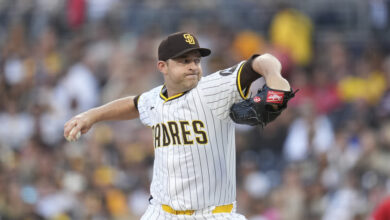
Here’s Why Nico Hoerner Might Actually Be Cubs’ 1A Option at 2B
Many expected the Cubs to make an upgrade at second base this offseason and it was reported that the team was still in search of a lefty-batting keystone up until just before camp opened. That’s because, among other she team’s production at the position, led by veteran Jason Kipnis and supplemented by Nico Hoerner and David Bote, fell comfortably in the bottom half of baseball last year.
As the Kolten Wongs of the world fell into the laps of other teams, there was widespread surprise that the Cubs opted not to retain the leader of what was already a week group when Kipnis announced his own signing with the Braves in mid-February. That departure, along with the absence of other notable additions, appears to put Bote and Hoerner in prime position to take charge at second this year.
Many have seen it as a foregone conclusion that Hoerner would spend a significant amount of 2021 playing regularly in Iowa as he makes up for development lost to injury and other circumstances. The young middle infielder’s foray into big league regularity came much sooner than expected and hasn’t always gone well. In slashing .222/.312/.259 with a 63 wRC+ (that’s 37% below league average), his offensive production was nothing short of dreadful in last year’s pandemic-shortened campaign.
Of course, the plan was never to have him playing regularly in the big leagues all year in 2020. Like so many plans, his developmental trajectory was severely impacted by COVID. The Cubs reasonably decided that competing at a level he wasn’t quite ready for was a better fit for his development than not playing competitive baseball at all.
The reality that extenuating circumstances contributed to Hoerner’s struggles last year does not in itself mean Cubs fans should roll into 2021 with rosy-eyed optimism about his performance this season. However, there are good reasons to believe in his improved fit as a regular this year.
First, and perhaps most notably, not every aspect of Hoerner’s game was in the dumps last year. His glove, long thought to be an asset and magnified even further by his shift down the defensive spectrum, largely held up despite his offensive struggles.
For those who wanted to add a defensive wizard like Wong due to a belief that the Cubs’ revamped, grounder-heavy pitching staff will need high-level defense behind it, Hoerner is unquestionably the team’s best option at second. While defensive statistics require more data than he has produced has to be truly reliable, his career 3.0 UZR/150 is a solid mark and largely matches the eye test.
There’s also some reason for optimism on the offensive front, and not just because Hoerner was snakebitten by such poor results last year. In addition to the potential to bounce back in a positive direction, he represents a different kind of hitter than those that make up much of the Cubs lineup. Despite the struggles, Hoerner was well better than league average in strikeout percentage and was near the top 10% of the league in avoiding swings-and-misses.
As for the overall results, there’s at least some reason to think his poor performance was due at least in some part to significant levels of bad luck, leading to worse results than he deserved. No one will confuse last year’s version Hoerner for someone who was actually an above-average offensive producer, but there is reason to suspect he should have been better than he was.
Consider a comparison to the aforementioned Wong, whose .300 wOBA far outpaced Hoerner’s .262 mark. When using Statcast’s advanced metrics to explore expected numbers, though, things get a little murkier. Hoerner’s expected wOBA, or xwOBA, actually came out three points higher than Wong’s (.289 vs .286). Hoerner also hit the ball harder than Wong, with a 37.2 hard-hit percentage compared to Wong’s 26.6, and barreled it twice as often.
This isn’t exactly a battle of the titans, as Wong came in about 10% below the average major league hitter, but those were largely the results he deserved. Coupled with outstanding defense, just being close to average at the plate made him a valuable player last year. While the Cubs would certainly like to see Hoerner become an above-average offensive producer in the future, he may not have to do that to become a valuable asset.
Seen through this lens, it makes a little more sense that the Cubs felt justified rolling the dice with their former first round pick instead of bringing in outside help. If Hoerner can keep his underlying peripherals roughly in line with last year’s and make even small improvements with a more athletic swing, there is ample reason to believe he’s a key piece to the Cubs being competitive in 2021.

